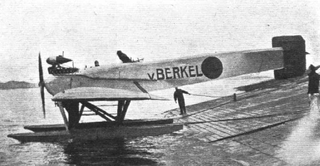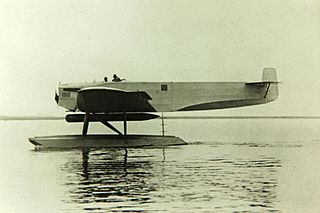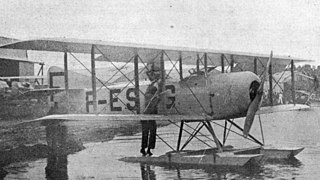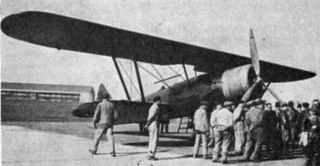
The FBA Type H was a French reconnaissance flying boat produced in large numbers in France and Italy during World War I by Franco-British Aviation.
The Latécoère 440 was a single-engined, high-winged float plane built as a coastal defence aircraft for the French Navy in the early 1930s. Two were produced to contract but did not impress in tests and the Navy chose instead the Latécoère 290.

The Hispano Suiza E-30, later renamed Hispano E-30, was designed in Spain in 1930 as a multi-purpose intermediate trainer. It was a single engine, parasol wing monoplane. About 25 served with the Spanish armed forces until 1945.

The Van Berkel W-B was a single engine Dutch long range reconnaissance seaplane built in the early 1920s for work in the Dutch East Indies. Six were operated by the Dutch Naval Aviation Service (MLD) with disappointing results, though the last two were not decommissioned until 1933.
The NVI F.K.29 was a small Dutch biplane transport, carrying two passengers who boarded after the nose, with its single engine and fuselage, had been swung open. It was intended to link small local fields to main airports.

The NVI F.K.32 was a tandem two-seat biplane training aircraft designed and built in the Netherlands in the mid-1920s. It did not go into service.

The Fokker T.III or T.3 was a single engine floatplane designed in the Netherlands in the early 1920s as a bomber or torpedo bomber.

The Nieuport-Delage NiD 43 was a single engine, two seat biplane fighter aircraft designed and built for shipboard use in France in 1924.

The Hanriot HD.15 was a French two seat fighter aircraft fitted with a supercharger for good high altitude performance, built in the 1920s. Three were ordered by Japan but lost at sea during delivery.

The Levy Biche LB.2 was a single seat French sesquiplane fighter aircraft designed to be used from aircraft carriers. With a watertight fuselage, jettisonable wheeled undercarriage and small under-wing floats, it could survive emergency sea touchdowns; it could also be fitted with seaplane type floats.

The Caudron C.65 was a single seat biplane floatplane designed and built in France in 1922. Only one was completed.

The Aviméta 88 was an all-metal French two-seat reconnaissance-fighter or heavy fighter tested in 1927.

The Lioré et Olivier H-23-2 was an amphibious maritime reconnaissance flying boat, built in France in 1932. Three were produced for the Venezuelan Army Air Service.

The Potez 50 or Potez 50 A2 was a French two seat military multi-rôle aircraft, first flown in 1931. It did not go into service but seven variants using five different engines were produced, one of them setting several speed with useful load records and another, the Potez 506, setting three altitude world records.

The Wibault 260 R.2 was a contender for a French government contract for a long range, two seat reconnaissance aircraft, issued in 1928. There were eight prototypes in the 1931-2 contest and the Wibault was not selected for production.

The CAMS 80 was an amphibious reconnaissance flying boat flown in the early 1930s. Two were built with different engines and were used by the Aéronavale for VIP transport and equipment development until 1938.
The Nieuport-Delage NiD 450 was a French racing floatplane, originally intended to compete for the 1929 Schneider Trophy. After the French decided not to participate that year, the type was used as the NiD 650 to speed the development of the proposed entrants to the 1931 event, the NiD 651 and NiD 652. Delays in producing the latters' engines left these unflown.

The Hanriot H.34 was a basic trainer designed in France in 1924 which did not reach production. It was a parasol wing aircraft, seating two in tandem.

The CAMS 54 was a strengthened and more powerful version of the French CAMS 51 civil transport and naval reconnaissance flying boat, developed for transatlantic flights. It is sometimes referred to as the 54 GR.

The Rohrbach Ro III was a twin-engined, all-metal flying boat built in Germany in the mid-1920s. A development of the Ro II, it could be configured either as an airliner or a reconnaissance aircraft. It was developed into the similar but more powerful Ro IIIa Rodra, intended only as a military reconnaissance/bomber. Four Ro IIIs were bought by Japan and two Rodras by Turkey.



















